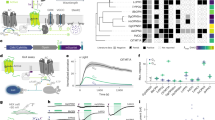Abstract
RECENT pharmacological investigations by us1 on the central nervous system of the mollusc Aplysia depilans revealed acetylcholine as a possible synaptic transmitter of inhibition. The evidence was obtained by electrophysiological methods; different cells in the abdominal ganglion of this animal were impaled by glass microelectrodes according to previously described techniques2 and their reactions observed in the presence of different drugs. It was thus shown that externally applied acetylcholine in concentrations up to 10−12 hyperpolarizes the membrane and mimics the inhibitory postsynaptic potentials in cells having inhibitory input (conventionally designated as H-cells), whereas other cells having only excitatory input (D-cells) are depolarized by acetylcholine (Fig. 1A). In both cases the impedance of the membrane drops to a low level. The action of acetylcholine on H-cells is reversed when the level of polarization of the membrane is increased by artificially applied current. The reversal-level for acetylcholine potentials and inhibitory postsynaptic potentials have equal values, suggesting an identical selective permeability variations of the membrane. In D-cells the equilibrium-level is close to the zero membrane potential, indicating a different and non-selective permeability change. Local electrophoretical injections of acetylcholine disclosed a type of response which is identical in synaptic regions as well as in proximal extrasynaptic membranes; but the axonal synaptic fields are more sensitive to acetylcholine than the somatic membrane where, as usual in molluscs, there are no synaptic terminals3. D-Tubocurarine and atropine in external solutions reduce the inhibitory postsynaptic potentials as well as the action of acetylcholine, whereas eserine first lengthens the inhibitory effect and then reduces the size of inhibitory postsynaptic potentials by inactivating the postsynaptic membrane; excitatory postsynaptic potentials in H-cells are not affected. Consequently, we concluded that the inhibitory synapse in the Aplysia central nervous system is cholinergic.
This is a preview of subscription content, access via your institution
Access options
Subscribe to this journal
Receive 51 print issues and online access
$199.00 per year
only $3.90 per issue
Buy this article
- Purchase on Springer Link
- Instant access to full article PDF
Prices may be subject to local taxes which are calculated during checkout
Similar content being viewed by others
References
Tauc, L., and Gerschenfeld, H., C.R. Acad. Sci., Paris, 251, 3076 (1960).
Tauc, L., Arch. ital. Biol., 96, 78 (1958).
Tauc, L., J. Physiol., 152, 36P (1960).
Inhibitions of the Nervous System and Gamma-aminobutyric Acid (Pergamon Press, 1960).
Welsh, J. H., and Moorhead, M., J. Neurochem., 6, 146 (1960).
Welsh, J. H., N.Y. Acad. Sci., 66, 618 (1957).
Author information
Authors and Affiliations
Rights and permissions
About this article
Cite this article
GERSCHENFELD, H., TAUC, L. Pharmacological Specificities of Neurones in an Elementary Central Nervous System. Nature 189, 924–925 (1961). https://doi.org/10.1038/189924a0
Issue Date:
DOI: https://doi.org/10.1038/189924a0
This article is cited by
-
Distribution ofγ-aminobutyric acid (GABA) in the ganglia ofAplysia kurodai
Experientia (1977)
Comments
By submitting a comment you agree to abide by our Terms and Community Guidelines. If you find something abusive or that does not comply with our terms or guidelines please flag it as inappropriate.



